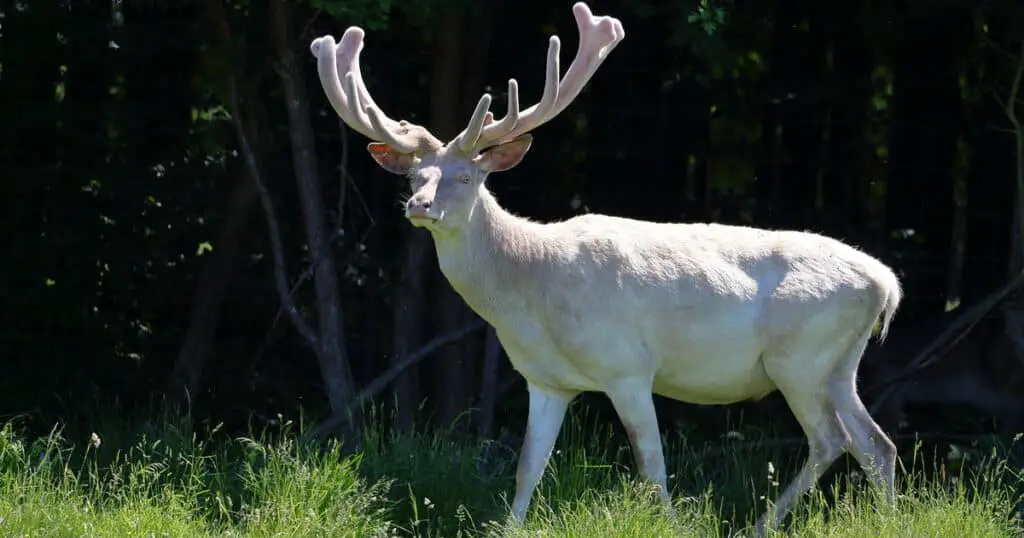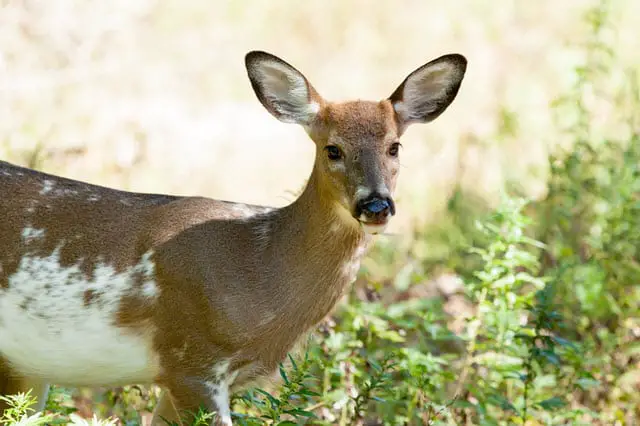An albino animal is a very rare sight to see, no matter the animal. Albino deer are no exception, and you should consider yourself very lucky if you happen to spot one.
Albinism is caused by a rare genetic malfunction that makes the animal, in this case a deer, appear white when it should be another color.
Albino deer are very rare, especially in the wild. As such, they have specific hunting laws surrounding them that should be adhered to. Albino deer also have meaningful symbolism in some cultures.
The following article is a detailed and thorough explanation of everything you should know about albino deer.
The Genetics of Albinism
Albinism is caused by a cell’s inability to produce something called melanin. Melanin is what gives skin, fur, and other attributes color.
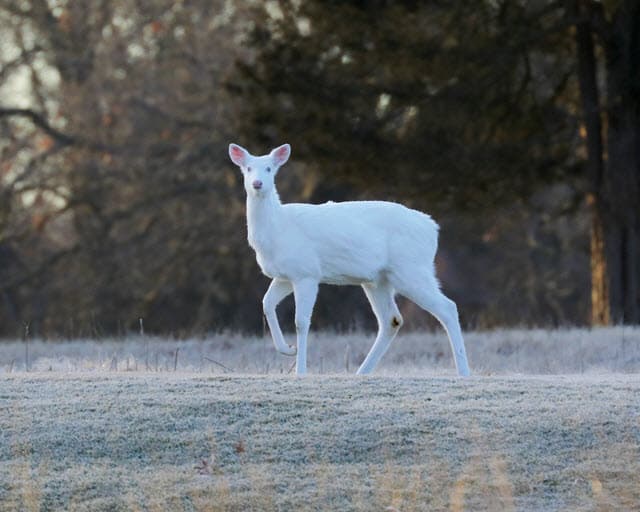
The more melanin the cells produce, the darker the animal will be. An albino deer’s cells have little to no melanin, which gives it the bright white appearance.
The condition is passed down from parents to offspring when both of the parents carry the recessive melanin gene. If one or neither of the parents has the gene, then the offspring won’t be albino.
This is what makes the condition so rare, as the likelihood of both a doe and a buck having the recessive gene is extremely low.
Deer born with albinism also suffer from other conditions, mainly bad eyesight. Melanin also helps to develop eyes and sight, mainly the irises and retinas. Without them, the deer can have issues with depth perception and tracking.
Another struggle that albino deer have is blending in with the environment around them. Their forest home is mainly brown and green, so a white deer will definitely stand out.
This makes albino deer an easy target for hunters and predators.
As a result, albino deer are usually abandoned by their herd since they put the other deer in danger. This is another reason albino deer are so rare, with the abandonment and how easy they are to spot, they often don’t survive that long.
This increases the rarity of the albino gene being passed down, so an albino deer is very rare indeed.
How Rare Are Albino Deer?
The chances of a deer being an albino are about one in 20,000. The recessive gene combined with their low chances of survival make albino deer a rare sight, but not as rare as melanistic deer.
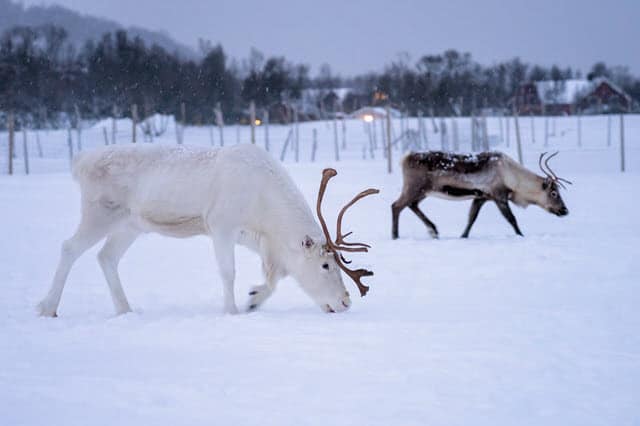
Melanistic deer are the exact opposite of albino deer; they have too much melanin in their cells, rather than not enough.
Melanistic deer appear all black in color, and they make up about 8.5 percent of the entire deer population. Melanistic deer are also a rare sight, but not as rare as albino deer.
Albino Deer Meaning
There are some cultures that believe seeing an albino deer is a sign of something. In Native American belief systems, an albino deer is a significant sign of prophecy.
They believed it was a sign from the spirit realm of a great change to come to their world. Anyone that saw a white deer should expect a massive change in their life, and soon.
The general meaning behind an albino deer is the following:
- Purity of soul
- Higher thoughts and ideals
- Cleansing of spirit
- Attaining higher knowledge
White is seen as the cleanest color, so it’s associated with purity of thought and soul. Seeing a white deer can be a good omen in this regard.
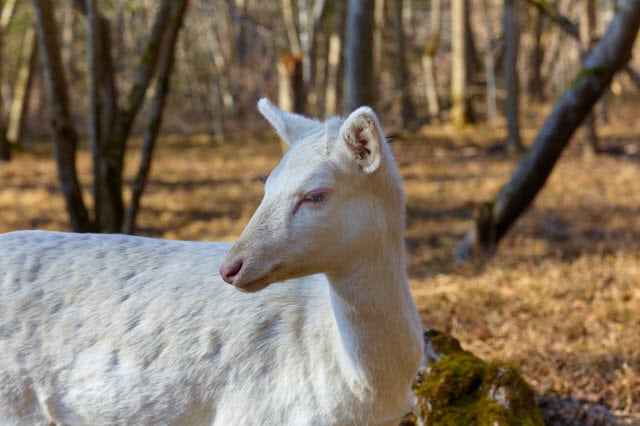
It can mean that your soul is pure, your intentions are meant to benefit you and other people, and you are on the best path for your life.
On the other hand, it can mean that your soul and spirit needed cleansing. A white deer can then symbolize that your spirit is on the path to being cleansed and renewed.
The symbolism of a white deer can also be coupled with whether a deer is a buck or a doe. If a deer is a doe, then they are thought to symbolize:
- Benevolence
- Kindness
- Spirituality
If a deer is a buck, then they are thought to symbolize:
- Abundance
- Endurance
- Longevity
Overall, the symbolism of a white deer is a good omen. It means that you are aware of your spirit and the condition it’s in.
Whether you take it as a sign to pursue something good in your life, or to reevaluate the path you’re on, a white deer is a positive sign that brings good things.
White Deer Symbolism
While the general symbolism of a white deer is well meaning, each culture has its own symbolism and legends behind the white deer. The main cultures that have significant symbolism for the white deer are:
- European cultures
- Asian cultures
- Native American cultures
In the mythology of European cultures, animals have significant symbolism when it comes to their appearance.
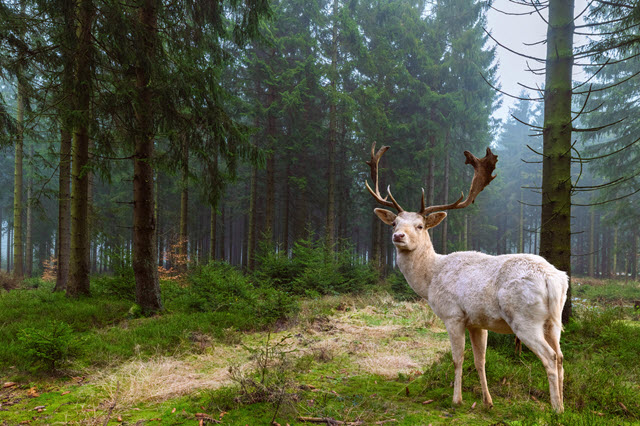
For example, if an animal is categorized as strong, then it’s believed that that animal has a supernatural power linked to physical strength.
In Europe
When it comes to white deer, European cultures believe that its color symbolizes humanity’s neverending spiritual quest. White is believed to be pure, and a white deer holds all of the spiritual knowledge in the world.
Furthermore, it’s believed that white tail deer have an incredible ability to avoid being captured. As a result, it serves as a reminder that humankind will never be able to fully understand the entire scope of spirituality in the world.
If you want to get even more specific about white deer symbolism in European cultures, then the Celtic culture also has its own interpretation.
In the legend of King Arthur, there is usually a white stag that appears in the forest that surrounds King Arthur’s court.
The stag sends the knights of the round table on noble missions against evil gods and fairies. The most well known Celtic legend behind white deer is that of King Arthur and Sir Pellinore’s well.
It’s said that King Arthur and his knights arrived at the well of Sir Pellinore, the killer of King Lot, after following a white stag.
This legend led to the symbolism of white deer being that of a spiritual guide in Celtic culture. It’s believed that if you see a white deer in the forest, you should immediately follow it, since it will lead you to your destiny.
In Asia
There is also a significant symbolism of white deer in Asian cultures. For example, in Hungarian mythology, it’s believed that a white stag led two brothers to establish the Hun and Magar people.
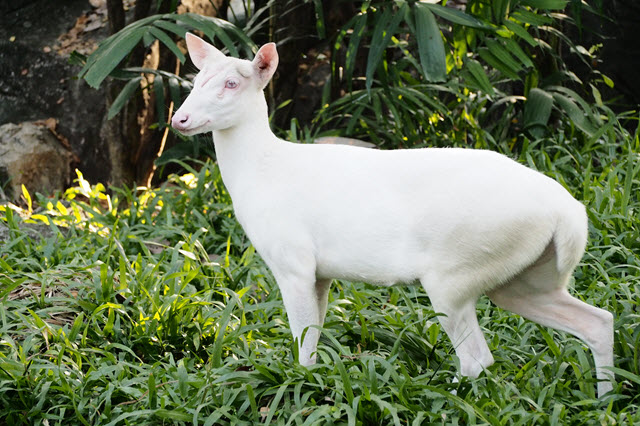
This legend led the symbolism of white deer to be steeped in new beginnings. It has since been said that if you saw a white deer, something significant was about to happen in your life.
The more well known Asian legend surrounding white deer is the legend of Hakushika. The name directly translates to “white deer”, and tells the story of the longest reigning emperor in Chinese history.
One day, the emperor spotted a white deer feeding near the palace gardens. The deer was also adorned with a bronze medal stating it was one thousand years old. The emperor took this deer as an omen of longevity and prosperity.
In Native American Culture
Lastly, Native American cultures have the most symbolism surrounding white deer. One of the main legends featuring white deer is from the Chickasaw tribe.
It tells the story of a young warrior promising to bring back the hide of a white deer to his bride. When he found it, he attempted to shoot and kill it, but the legend says the deer charged him and took his soul.
The white deer is now a sacred symbol to the Chickasaw tribe, and sometimes white deer skin is used as wedding dress material.
The legend also created white deer as a symbol of promising and everlasting love, and so brides would wear the skin on their wedding day in order to bless their union.
Leucistic vs Albino Deer
Albinism isn’t the only genetic mutation that a deer can have. A few other rare genetic mutations that deer can be born with are leucism and piebaldism.
These conditions are very similar to albinism, but there are a few key things you should know about so you can tell the difference.
Similarities
Firstly, a few similarities between leucism and albinism are:
- A reduction in melanin cells
- It’s usually passed down from offspring to parents
- Both conditions are very rare
Leucism and albinism are both conditions that cause a reduction in melanin production. As stated prior, melanin is what gives deer and other animals the color of their coat, fur, feathers, and other characteristics.
The loss of color is primarily due to the offspring inheriting a recessive gene from both parents.
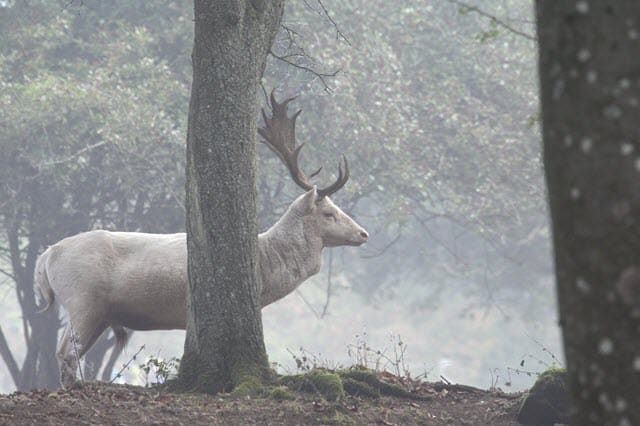
Genes are what determine what a parent’s offspring will look like. For example, when it comes to white tail deer, a fawn will inherit a gene from their parents that makes its tail appear white or their antlers appear large.
Genes can be apparent or recessive, so if a white tail deer inherits a recessive gene from one parent, then their antlers might not be as big or their tail might not appear white.
This can happen with albino and leucistic deer. If both parents have a recessive gene that affects their coloration, and the offspring inherits that gene from both parents, they will appear less colorful or even devoid of color.
The last similarity between albinism and leucism is that they are both very rare conditions. Albinism occurs in about one in 20,000 of all deer, as stated before. Leucism occurs in deer at a rate of about one to two percent of all deer.
So seeing a deer with these conditions is almost unheard of, but not impossible.
Differences Between Leucistic and Albino Deer
A few of the key differences between leucism and albinism include:
- Albinism affects the entire deer, while leucism only partially affects the deer
- Leucism doesn’t affect the eyes or nose, while albinism does
- Leucistic deer generally survive longer than albino deer
Albinism causes the deer to have no pigmentation whatsoever on their entire body. They will be completely white from head to toe, not including a few pink patches on their noses and in their ears.
Leucistic deer, on the other hand, won’t be completely white all over. Leucism is a condition where all types of pigments are reduced, instead of just melanin.
As a result, deer with leucism usually just have muted colors or an irregular pattern of white patches over their bodies.
However, leucistic deer can still appear all white. Fortunately, there are other ways to tell the difference between albinism and leucism.
Nose and Eyes
The noses and eyes of leucistic deer will appear normal, with the eyes of these deer being a dark brown or black color and the nose being completely black.
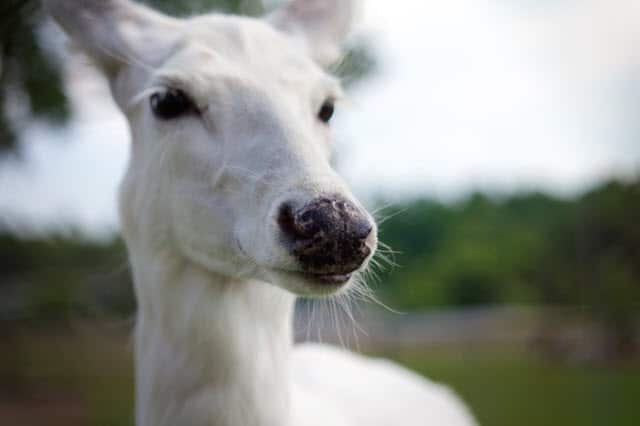
A deer with albinism will typically have a pink nose and red eyes. This is because leucism will only affect a few parts of the deer’s body, and their body is the most often affected.
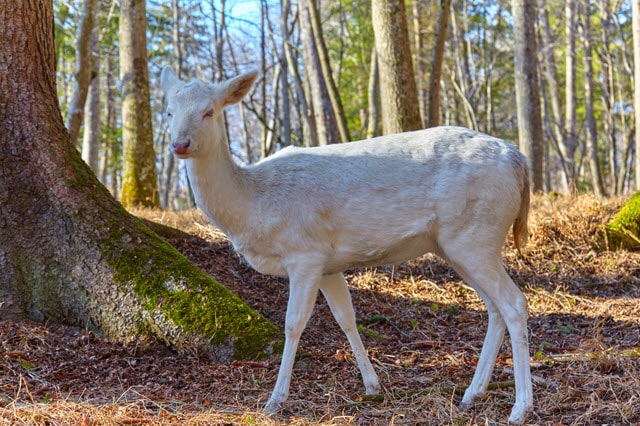
Leucistic deer will still have some melanin in their system, so they will still have some sort of color other than white present.
Lastly, leucistic deer are more likely to survive in the wild than albino deer. Deer that are born with leucism still have a harder time surviving, often being excluded by their herd and an easier target for predators.
But leucistic deer still have a longer average lifespan than albino deer since they still partially have some color camouflage. The less white there is on their bodies, the more likely they are to survive.
Piebald vs Albino Deer
Another common genetic mutation that deer can experience is piebaldism. This condition is often mistaken for leucism, and while it’s similar to that and albinism, piebald deer have a few key differences.
The similarities between piebaldism and albinism include the genes must be passed from parent to offspring and both conditions cause mutations in color.
The main difference between albinism and piebaldism is that the latter often causes symmetrical patches of white, rather than a full white coloration.
Just like with each of the genetic mutations discussed so far, a piebald deer must receive a recessive pigmentation gene from each parent.
Furthermore, deer offspring that receive these recessive traits are often considered biologically inferior, because they likely won’t pass the recessive gene onto their offspring if they live long enough to do so.
Piebaldism and albinism also both cause mutations in color. Albinism will make the deer white all over, while piebaldism will make some parts white and some parts the deer’s regular color.
But one of the best ways to distinguish between piebaldism and leucism is how symmetric the white color pattern is. Piebald deer are usually half brown and half white, while leucistic deer have more randomized patches of white.
It can be difficult to tell the difference, but it is possible.
Can You Shoot an Albino Deer?
There is a lot of debate around the question of shooting albino deer, or any deer with a genetic mutation. The short answer is that yes, you can shoot an albino deer.
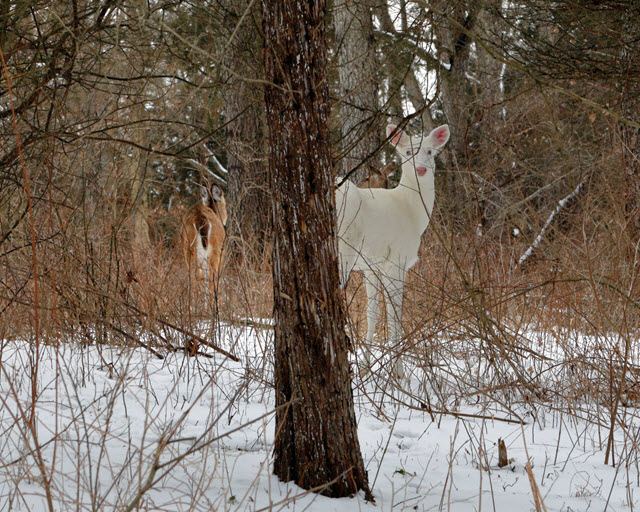
As long as there are no hunting regulations against it in the state you’re hunting in, you can shoot an albino deer if you spot one.
However, there are a few factors you should consider while deciding if you should shoot the deer or not.
Should You Shoot an Albino Deer?
The main argument that hunters should shoot an albino deer is that it’s an act of mercy. Because albino deer are genetically inferior, they often face a large amount of health and survival problems.
Why Shooting an Albino Deer May Be Merciful
The most notable ones are problems with vision and being an easier target for predators.
Deer born with albinism often also have issues with their vision. They usually don’t have good depth perception and have a hard time seeing what is good to eat and what is bad to eat.
They also have a harder time seeing predators and running away in time. As a result, shooting them might prevent them from having a more painful death from starvation or getting mauled by a predator.
Albino deer also present problems for the herd they are in, if they do in fact have a herd. Deer management is about keeping the herd healthy and doing whatever is in their best interest.
Unfortunately, an albino deer usually brings danger to the herd. Since it’s easier for predators to spot, it can lead them straight to their herd and present even bigger problems. Because of this, shooting one deer can help save many more.
Why You May Not Want to Shoot Albino Deer
The main argument against shooting albino deer mainly has to do with the spiritual meaning behind them. Many cultures, especially Native American ones, consider white deer a sacred symbol and a bringer of good fortune.
To shoot one would be disrespectful, and could even bring misfortune into your life.
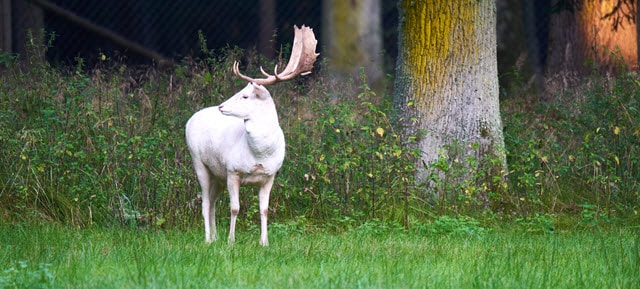
Overall, it’s up to you whether you shoot an albino deer or not. However, there are sometimes regulations for shooting an albino deer, so it’s recommended to check those before you go hunting so you don’t get in trouble.
Final Thoughts About Deer with Albinism
Albino deer are a fascinating sight to see, and the rarity of them makes spotting one even more exciting. They have diverse meanings and legends surrounding them, each one different from culture to culture.
Albino deer will continue to be an interesting sight to see and a fascinating subject to study in regards to genetics and genetic mutation.

